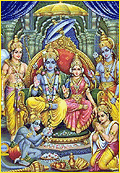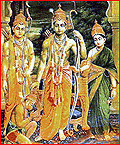


|
|

|
|
| HOME | DIWALI SPECIAL | |||
|
Days of Diwali |
 THE RAMAYANA  Dating back to 1500 BC (or the 4th century BC, according to some recent studies), the Ramayana narrates the story of Rama, in twenty four thousand stanzas. Composed by Valmiki in Sanskrit, the classical language of ancient India, the work is said to have been created by the sage in a state of pure inspiration. The Ramayana ends with the safe return of Rama, Sita and Laxmana to Ayodhya, after a period of exile. This is the mythological reason for the celebrations that make up Diwali. Here's the sequence of events, as they unfold in the epic. Dashratha is cursed Dashratha, the king of Ayodhya, had once set off to hunt deer. In the midst of the forest, he heard the sound of bubbles and saw some movement in the distance. Thinking it to be a deer drinking water, he shot an arrow in that direction. Much to his surprise, as his arrow found its mark, he heard a human being cry out. When he rushed to the spot, his disbelieving eyes saw a handsome youth fatally wounded by the arrow. Dashratha took the dying youth, whose name was Shravana to his (the youth's) blind parents, who were nearby. On witnessing the demise of their only son, they cursed Dashratha that he too would find himself in the same agonising state when his son would be snatched away from him. Three wishes are granted to Kaikeyi After the incident with Shravana, King Dashratha continued to reign over Ayodhya. He had three wives and four sons. His first wife, Kausalaya, bore him Rama, the second one Sumitra bore him Laxmana and Shatrugana and the last one Kaikeyi bore him Bharata. Each son was nobler than the other. Once, during a battle, a wheel of Dashratha's chariot came off. Kaikeyi, who had accompanied him to the battle, inserted her hand into the axle and held the wheel in place. Her brave gesture enabled Dashratha to win the battle. In return, Dashratha granted her three boons and told her to ask for anything she wanted. As she wanted nothing at that very moment, she reserved the right of asking for the fulfilment of these three wishes for a later date (some narrations of the Ramayana state that Kaikeyi was granted the boons as she pulled Dashratha aside to safety when he had fainted on the battle field. The general agreement is that the boons were granted for saving Dashratha's life on the battlefield). Rama goes into exile  After a few more years, when Dashratha's eldest son Rama attained manhood, Dashratha felt it was time for him to renounce worldly pleasures and relinquish his throne in favour of Rama. On hearing this, the people of Ayodhya were jubilant. But all did not share in this jubilation. Kaikeyi's maid, Manthara (or Kooni) was jealous of Rama, and, to prevent his accession to the throne, she went to Kaikeyi and instigated her against Rama, by telling her that if Rama became king, she (Kaikeyi) would lose her importance as queen. So she should ask that Bharata (Kaikeyi's son) be installed as king and that Ram be exiled for fourteen years. And, if Dashratha did not accept these demands, Kaikeyi should ask him to redeem the boons that he had granted her. In the beginning, Kaikeyi resisted Manthara's malicious advice, but, as temptation got the better of sagacity, she relented, and Dashratha had to redeem the three boons, by agreeing to Kaikeyi's wishes. These were:
After a few more years, when Dashratha's eldest son Rama attained manhood, Dashratha felt it was time for him to renounce worldly pleasures and relinquish his throne in favour of Rama. On hearing this, the people of Ayodhya were jubilant. But all did not share in this jubilation. Kaikeyi's maid, Manthara (or Kooni) was jealous of Rama, and, to prevent his accession to the throne, she went to Kaikeyi and instigated her against Rama, by telling her that if Rama became king, she (Kaikeyi) would lose her importance as queen. So she should ask that Bharata (Kaikeyi's son) be installed as king and that Ram be exiled for fourteen years. And, if Dashratha did not accept these demands, Kaikeyi should ask him to redeem the boons that he had granted her. In the beginning, Kaikeyi resisted Manthara's malicious advice, but, as temptation got the better of sagacity, she relented, and Dashratha had to redeem the three boons, by agreeing to Kaikeyi's wishes. These were:
Ram battles Ravana  In exile, Sita was abducted by Ravana (King of Rakshashas) and taken to his abode Lanka (modern day Sri Lanka or Ceylon). Rama and Laxmana collected an army with the help of the monkey king Hanuman and rescued Sita. Ram returns At the end of fourteen years, Rama, Laxmana and Sita returned to Ayodhya and were given a rousing welcome by the people, who lit up the city with lights to celebrate their return. Lord Rama reigned for a long time during which the people were happy and contented. In fact, the phrase "Ramrajya", or the reign of Rama, signifies an era of peace and prosperity. View the characters If you know of any other legends from the Ramayana or any other sources, that pertain to Diwali, do share them with us. TOP
|
|
HOME |
NEWS |
BUSINESS |
SPORTS |
MOVIES |
CHAT |
INFOTECH |
TRAVEL SHOPPING HOME | BOOK SHOP | MUSIC SHOP | HOTEL RESERVATIONS EDUCATION | PERSONAL HOMEPAGES | FREE EMAIL | FEEDBACK |